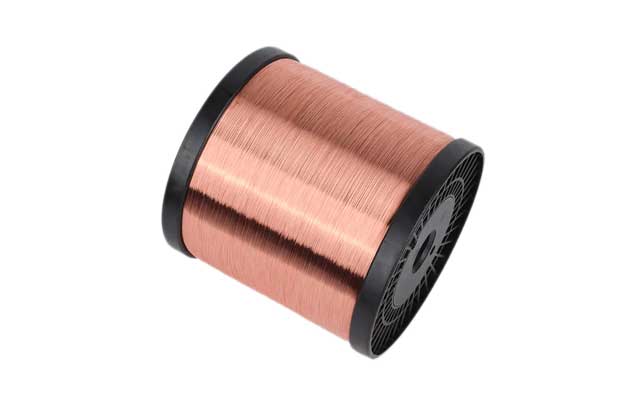Symbol CCSPurity /Size 0.08 -4.00 mmType Composite wireElongation /Tensile /
Copper-clad Steel Wire
Copper clad steel wire is a composite metal wire with high-strength steel wire as the core material and an outer layer of copper coating. It has the mechanical strength of steel and the electrical/thermal conductivity of copper, making it a special functional material in fields such as power, communication, and construction.
Core Features
High strength: The tensile strength of the steel core can reach 1000-2000 MPa, which is 3-5 times that of pure copper wire.
Conductivity: The copper layer provides a conductive pathway, with a conductivity of up to 30% to 70% of pure copper (depending on the thickness of the copper layer).
Corrosion resistance: The copper layer isolates the steel core from corrosive media, extending its service life.
Lightweight: The density (7.8~8.9 g/cm ³) is lower than that of pure copper (8.96 g/cm ³), making it suitable for scenarios that require weight reduction.
Classification
Conductive type: Copper layer thickness ≥ 15% wire diameter, conductivity ≥ 40%, suitable for communication cables and RF coaxial lines;
Enhanced type: Copper layer thickness of 5%~10%, tensile strength ≥ 1500 MPa, suitable for tire cords and elevator cables;
Corrosion resistant type: Copper layer is dense and pore free (coverage rate ≥ 95%), suitable for marine engineering and chemical equipment.
Manufacturing Process
The mainstream production processes for copper-clad steel wire include electroplating, cladding welding, and hot-dip coating
Electroplating Method (low-cost, thin coating)Steel wire pretreatment:
Acid washing (10% H2 SO4) to remove oxide scale, and electrolytic degreasing (NaOH solution) to clean the surface.
Electroplated copper:
Plating solution formula: Copper sulfate (CuSO4· 5H2O) 200-250g/L, sulfuric acid (H2SO4) 50-70g/L, additives (such as polyethylene glycol) 0.1-0.5g/L.
Current density: 2~5 A/dm ², temperature: 20~40 °C, plating speed: 5~20 μm/min.
Post processing:
Passivation (chromate solution) to prevent oxidation, drawing and shaping to the target wire diameter.
Cladding Welding Method (high bonding strength, thick coating)Copper tape wrapping:
Copper strip (thickness 0.1-1mm) wraps around steel wire, with edges overlapping by 1-3 mm.
High frequency welding:
High frequency current (100-400kHz) melts the edge of the copper strip to achieve metallurgical bonding, with a welding temperature of 800-1000 °C.
Rolling and drawing:
By rolling with a mold, the copper layer is tightly adhered to the steel core, with a surface roughness Ra ≤ 1.6 μm.
Hot Dip Plating Method (thick coating, simple process)Assisted plating treatment:
The steel wire is immersed in an ammonium zinc chloride solution (concentration 20%~30%) and dried to form a co coating.
Hot dip copper plating:
The temperature of the molten copper solution is 1100-1200 °C, the immersion time is 10-30 seconds, and the thickness of the copper layer is 0.5-2 mm.
Cooling and shaping:
After water or air cooling, the surface is polished.
Copper-clad Steel Wire List
| Diameter |
Tolerance |
Elongation |
Tensile Strength |
| 0.08 -4.00 mm |
±1% |
≥10% |
≥310 MPa |
Copper-clad Steel Wire Application
Copper clad steel wire has the advantages of high strength and conductivity, high cost-effectiveness, better corrosion resistance than ordinary steel wire, lightweight design, and material cost savings. It can be widely applied in the following scenarios:
Communication and ElectronicsCoaxial cable: A single core wire with a diameter of 0.5-2mm is used as a shielding layer to suppress electromagnetic interference (EMI).
5G base station antenna: Multi core twisted wire is used for RF signal transmission to reduce signal attenuation.
Electricity and EnergySubmarine cable: with a cross-sectional area of 300mm ², twisted wire as the armor layer, tensile strength ≥ 1800 MPa, and resistance to seawater corrosion.
Photovoltaic bracket: Copper coated steel wire instead of pure copper, with a cost reduction of 40%.
Transportation and ArchitectureTire cord: ultra-fine wire with a diameter of 0.15~0.25mm, enhancing the impact resistance of the tire (fracture strength ≥ 3000 MPa).
Architectural curtain wall cable: diameter 3-8mm wrapped welding wire, tensile strength ≥ 1600 MPa, service life ≥ 30 years.
Industrial EquipmentElevator cable: multi-core twisted wire, safety factor ≥ 12 times.
Mining steel wire rope: hot-dip copper-clad steel wire, wear-resistant and corrosion-resistant.
Military and Aerospace IndustryMissile wire: electroplated copper-clad steel wire, high temperature resistant.
Satellite antenna: ultra lightweight twisted wire, reducing launch weight.


